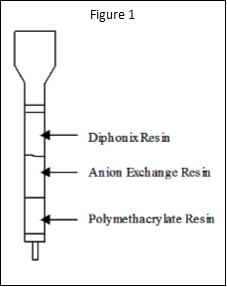Eichrom’s Tritium Column is designed as an alternative or compliment to distillation for most routine tritium analyses of aqueous samples. The Tritium Column works by removing metal ions which may be potential interferences in the LSC spectrum of 3H. The Tritium Column is not intended to be an enrichment procedure. Therefore, the Tritium Column should only be used when the required detection limit can be achieved by the direct counting of a 5-10 mL aliquot of the sample processed through the tritium column.
Figure 1 shows the composition of the Tritium Column and Table 1 explains the purpose and capacity of each component. The Diphonix® Resin removes cations in exchange for hydrogen ions, with a theoretical capacity is 0.8 meq per Tritium Column. The anion exchange resin, a chloride form analytical grade 1X8 resin, exchanges anions in the sample for chloride ions. The polymethacrylate resin removes organically bound tritium and carbon-14 and other organic material which may cause quenching in the LSC cocktail.
Table 1
| Component | Target | Capacity |
| Diphonix® Resin | Cations | 0.8 meq |
| Anion Exchange Resin | Anions | 0.8 meq |
| Polymethacrylate Resin | Organic Molecules | 50 mg |
Table 2 shows the average spike recoveries for a variety of sample matrix types passed through the Tritium Column.
Table 2
Spike Recovery Results using Tritium Column
| Sample Type | Volume | 3H Spike (Bq) | % Recovery |
| Distilled water | 15 mL | 97.2 | 96.4% (n=4) |
| Distilled water | 25 mL | 20.2 | 87.6% (n=4) |
| Distilled water | 25 mL | 19.5 | 94.9% (n=7) |
| Ground water | 25 mL | 17.1 | 91.2% (n=5) |
| Sea water | 25 mL | 4.0 | 90.0% (n=6) |
| Urine | 25 mL | 85.1 | 91.1% (n=4) |
The column successfully removes potential radioactive interferences. In a study performed at Eichrom, a mixture of radioisotopes (60Co, 137Cs, 233U, 90Sr/90Y, 210Pb, 230Th, total activity 16.9 Bq) was spiked into eight tritium-spiked solutions (distilled and sea water samples). In every case, after passing the sample through the Tritium Column, the number of counts in the region above the tritium window was not different than the number of counts in the same region of an unspiked sample. (See Table 3 )
Table 3
Results of contamination study
| Sample Type | Volume | 3H Spike (Bq) | Contaminant spiked (Bq) |
Contaminant found(Bq) |
| Distilled Water | 25 mL | 19.5 | 16.9 | |
| Distilled Water | 25 mL | 20.2 | 16.9 | |
| Sea water | 25 mL | 4.0 | 16.9 |
In another experiment, Daniel Cahill of Carolina Power & Light measured the activity of fission and activation products in PWR and BWR reactor coolant samples before and after passing through Eichrom’s Tritium Column. Table 4 summarizes the before column activity of each sample. After the column, no measurable activity was detected in the BWR sample and only a trace level of activity of 60Co with > 50% counting error was detected in the PWR sample. Because the amount of 60Co measured was so low and the error so high, and because the BWR sample contained more than 10 times the 60Co before the column and none after the column, it is assumed that the trace amount measured in the PWR sample is an artifact due to the background of the gamma counter.
Table 4
Carolina Power & Light Samples
| Isotope | PWR Sample | BWR Sample |
| Cr-51 | 2,900 | 1,999 |
| Mn-54 | 518 | 5,590 |
| Co-58 | 4,740 | 4,960 |
| Fe-59 | 109 | — |
| Co-60 | 392 | 5,990 |
| Sn-113 | 230 | — |
| Nb-95 | 4.220 | 116 |
| Zr-95 | 2.210 | — |
| I-131 | 14.200 | — |
| Cs-134 | 1,120 | — |
| Cs-137 | 1,320 | — |
| La-140 | — | 1,550 |
| Ce-144 | — | 203 |
D. Cahill, Carolina Power & Light, New Hill NC
See our newsletter archive for additional data on the performance of Eichrom’s Tritium Column. The studies reported here, and elsewhere on our website, conducted in Eichrom and customer laboratories, demonstrate that the Tritium Column performs equivalently to the traditional distillation technique. We encourage you to try using this column as a substitute for distillation of your aqueous tritium samples.
Eichrom’s Tritium column is manufactured as a 2 mL pre-packaged column (total bed volume of all three components.) It is available in packages of 20 and 50. Click here for part numbers and descriptions.
